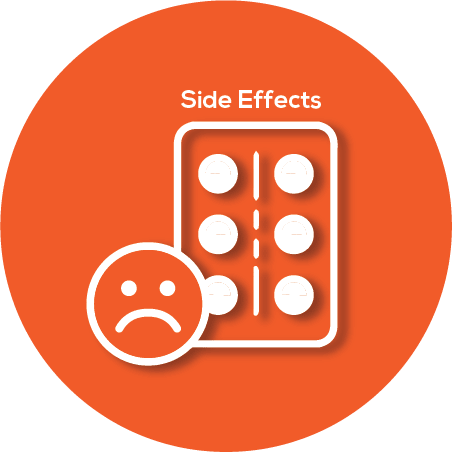Clima V 100mg/200mg Vaginal Capsule CLINDAMYCIN + CLOTRIMAZOLE
Clima V 100mg/200mg Vaginal Capsule contains Clindamycin and Clotrimazole, a medication specifically used to treat vaginal infections, including bacterial vaginosis and yeast infections. This combination medication features two essential components: Clindamycin, an antibiotic, is effective against bacteria and is crucial in eliminating bacterial infections. Clotrimazole, an antifungal agent, targets and eradicates yeast infections. Together, these two medications form a potent alliance, addressing both bacterial and fungal culprits that may be responsible for causing vaginal infections.
Follow your doctor's advice regarding the appropriate dosage and duration of this medicine before usage, cleanse and thoroughly dry the vaginal area.
While lying down, gently insert the suppository into the specified area, using an applicator if indicated on the label, and following the instructions provided. You or a caregiver may be instructed on proper usage at home to strictly adhere to the prescribed dosage and complete the full course of treatment as directed by your healthcare professional.
Inform your healthcare provider about any allergies or existing medical conditions to ensure safe usage.
During Tinidazole treatment, avoid alcohol consumption to prevent potential adverse reactions.
Common side effects of this medication may include erythema, stinging, blistering, peeling, vaginal pain, constipation, nausea, and headache. If you experience any of these symptoms, it's advisable to take note of them and consult your healthcare provider as needed.
In the event that you miss a dose, take it as soon as you remember. However, if it's close to the time for your next scheduled dose, it's best to skip the missed dose and continue with your regular dosing schedule. Avoid doubling the dose, as this may lead to potential side effects.

Are the medicines in combination of Clindamycin and Clotrimazole safe to take together?
Clindamycin, which is an antibiotic used to treat bacterial infections, and Clotrimazole, which is an antifungal used to treat fungal infections, generally do not have significant drug-drug interactions when used together. This means they can often be used at the same time without causing harmful effects. However, it's always important to be cautious and monitor for any unusual symptoms. To monitor for potential interactions, keep an eye out for any new or worsening symptoms, such as skin reactions or digestive issues. If you notice anything unusual, contact your healthcare provider. They may suggest adjusting the dosage or switching medications. Regular follow-ups with your doctor can help ensure that the medications are working effectively without causing any adverse effects.

Are there harms and risks from taking combination of Clindamycin and Clotrimazole?
Clindamycin, which is an antibiotic used to treat bacterial infections, can cause common side effects like nausea, vomiting, and diarrhea. A significant adverse effect is the risk of developing a severe intestinal condition called colitis, which refers to inflammation of the colon. Clotrimazole, which is an antifungal medication used to treat fungal infections, may cause side effects such as skin irritation, redness, or a burning sensation at the application site. Both medications can cause allergic reactions, which may include symptoms like rash, itching, or swelling. While Clindamycin is primarily used for bacterial infections, Clotrimazole is used for fungal infections, highlighting their unique attributes. However, they share the common attribute of potentially causing allergic reactions. It's important to use these medications as directed by a healthcare provider to minimize risks.

Can I take combination of Clindamycin and Clotrimazole if I am pregnant?
Clindamycin, which is an antibiotic used to treat bacterial infections, is generally considered safe during pregnancy. It is often prescribed when the benefits outweigh any potential risks. Clotrimazole, which is an antifungal medication used to treat yeast infections, is also considered safe for use during pregnancy, especially when applied topically. Both medications are used to treat infections, but they target different types of organisms: Clindamycin targets bacteria, while Clotrimazole targets fungi. A common attribute is that both are used to treat infections and are considered safe during pregnancy when used appropriately. However, it is always important to consult a healthcare provider before using any medication during pregnancy to ensure it is appropriate for the individual's specific situation.

Can I take combination of Clindamycin and Clotrimazole while breastfeeding?
Clindamycin, which is an antibiotic used to treat bacterial infections, is generally considered safe during breastfeeding. It passes into breast milk in small amounts, but it is unlikely to harm a nursing infant. However, it may cause some side effects in the baby, such as diarrhea or a rash. Clotrimazole, which is an antifungal medication used to treat yeast infections, is also considered safe for use during breastfeeding. It is applied topically, meaning it is used on the skin, and only a small amount is absorbed into the bloodstream, making it unlikely to affect the breastfed baby. Both Clindamycin and Clotrimazole are considered safe for breastfeeding mothers, but they have different uses and methods of application. Clindamycin is taken orally or applied topically, while Clotrimazole is usually applied topically. Both medications should be used under the guidance of a healthcare provider to ensure the safety of both mother and baby.

Can I take combination of Clindamycin and Clotrimazole with other prescription drugs?
Clindamycin, which is an antibiotic used to treat bacterial infections, can interact with other medications that affect the liver, as it is processed there. It may also interact with muscle relaxants, which are drugs that help reduce muscle tension, potentially increasing their effects. Clotrimazole, which is an antifungal medication used to treat yeast infections, is generally applied topically and has fewer systemic interactions. However, it can interact with other topical medications, potentially affecting their absorption. Both Clindamycin and Clotrimazole are used to treat infections, but they target different types. Clindamycin is for bacterial infections, while Clotrimazole is for fungal infections. They share the common attribute of being used to combat infections, but they work in different ways and have different interaction profiles. It's important to inform healthcare providers of all medications being used to avoid potential interactions.

For how long is combination of Clindamycin and Clotrimazole taken?
Clindamycin, which is an antibiotic used to treat bacterial infections, is typically used for a duration of 7 to 10 days, depending on the type and severity of the infection. It works by stopping the growth of bacteria. Clotrimazole, which is an antifungal medication used to treat fungal infections, is usually applied for 2 to 4 weeks. It works by stopping the growth of fungi. Both Clindamycin and Clotrimazole are used to treat infections, but they target different types of organisms. Clindamycin is for bacteria, while Clotrimazole is for fungi. They both share the common attribute of being used to stop the growth of harmful organisms, but they are not interchangeable. The duration of use for each depends on the specific infection being treated and the response to the medication.

How does combination of Clindamycin and Clotrimazole work?
Clindamycin is an antibiotic, which means it fights bacteria in the body. It works by stopping bacteria from making proteins they need to grow and multiply. Without these proteins, the bacteria can't survive, which helps to clear up infections. Clotrimazole, on the other hand, is an antifungal, which means it fights fungal infections. It works by damaging the cell membrane of the fungus, which is the outer layer that protects the fungus. This damage causes the contents of the fungal cell to leak out, killing the fungus. Both Clindamycin and Clotrimazole are used to treat infections, but they target different types of organisms. Clindamycin targets bacteria, while Clotrimazole targets fungi. Despite their differences, both medicines help to clear infections by stopping the growth of harmful organisms in the body.

How does one take combination of Clindamycin and Clotrimazole?
Clindamycin, which is an antibiotic used to treat bacterial infections, can be taken with or without food. However, taking it with food may help reduce stomach upset. There are no specific food restrictions while using Clindamycin, but it's important to follow your healthcare provider's instructions. Clotrimazole, which is an antifungal medication used to treat yeast infections, is usually applied topically and does not require ingestion. Therefore, food intake does not affect its use, and there are no food restrictions associated with it. Both Clindamycin and Clotrimazole are used to treat infections, but they target different types of organisms. Clindamycin is for bacterial infections, while Clotrimazole is for fungal infections. They do not share common food-related instructions due to their different methods of administration and action.

How do I know if combination of Clindamycin and Clotrimazole is working?
The benefits of Clindamycin and Clotrimazole are measured by their effectiveness in treating infections. Clindamycin, which is an antibiotic, is used to treat bacterial infections by stopping the growth of bacteria. Its benefit is assessed by the reduction or elimination of symptoms like pain, swelling, or fever associated with bacterial infections. Clotrimazole, which is an antifungal, treats fungal infections by stopping the growth of fungi. Its benefit is measured by the reduction of symptoms like itching, redness, or discomfort in the affected area. Both medicines share the common attribute of targeting specific types of infections, but they differ in the type of microorganisms they act against. The effectiveness of both is assessed by the improvement in symptoms and the resolution of the infection.

How do I store combination of Clindamycin and Clotrimazole?
Clindamycin, which is an antibiotic used to treat bacterial infections, does not require refrigeration. It should be stored at room temperature, away from moisture and heat. Clotrimazole, which is an antifungal medication used to treat yeast infections, also does not need refrigeration. It should be kept at room temperature, away from direct sunlight and moisture. Both Clindamycin and Clotrimazole share the common attribute of being stored at room temperature. They should be kept in a dry place, away from excessive heat and moisture, to maintain their effectiveness. However, they are used to treat different types of infections; Clindamycin targets bacteria, while Clotrimazole targets fungi. Despite their different uses, their storage requirements are quite similar, making it easy to manage them in a home setting.

How effective is combination of Clindamycin and Clotrimazole?
Clindamycin is an antibiotic, which means it fights bacterial infections by stopping bacteria from growing. It is often used to treat skin infections, respiratory infections, and some types of acne. Clotrimazole, on the other hand, is an antifungal, which means it treats infections caused by fungi. It is commonly used for conditions like athlete's foot, ringworm, and yeast infections. Both Clindamycin and Clotrimazole are effective in treating infections, but they target different types of organisms. Clindamycin targets bacteria, while Clotrimazole targets fungi. Despite their differences, they share the common attribute of being topical treatments, which means they are applied directly to the skin or affected area. This direct application helps in delivering the medication right where it's needed, reducing the risk of systemic side effects. Both medications are well-researched and have been proven effective in their respective roles through clinical studies.

How long does it take for combination of Clindamycin and Clotrimazole to work?
The time it takes for a combination medicine to start working depends on the individual medicines it contains. For example, if the combination includes ibuprofen, which is a pain reliever and anti-inflammatory, it typically starts working within 20 to 30 minutes. If it includes paracetamol, which is another pain reliever, it usually begins to work within 30 to 60 minutes. Both medicines are used to relieve pain and reduce fever, which means they share these common attributes. However, ibuprofen also reduces inflammation, which is swelling and redness, while paracetamol does not. When combined, these medicines can provide a broader range of relief, addressing both pain and inflammation more effectively. Always follow the dosage instructions provided by your healthcare provider or the medicine's packaging.

What disease or symptom is combination of Clindamycin and Clotrimazole used for?
Clindamycin is an antibiotic used to treat bacterial infections, which are illnesses caused by harmful bacteria. It is often prescribed for skin infections, respiratory infections, and infections of the female reproductive organs. Clotrimazole, on the other hand, is an antifungal medication used to treat fungal infections, which are illnesses caused by fungi. It is commonly used for conditions like athlete's foot, jock itch, and yeast infections. While both Clindamycin and Clotrimazole are used to treat infections, they target different types of organisms. Clindamycin is effective against bacteria, while Clotrimazole is effective against fungi. Despite their differences, both medications are used to clear infections and relieve symptoms. They are often used in combination to treat mixed infections, which involve both bacteria and fungi, especially in cases like vaginal infections.

What is combination of Clindamycin and Clotrimazole?
Clindamycin is an antibiotic used to treat bacterial infections, which are illnesses caused by harmful bacteria, by stopping the bacteria from growing. Clotrimazole is an antifungal medication used to treat fungal infections, which are illnesses caused by fungi, by disrupting the cell membrane of the fungus. Both medicines are used to treat infections, but they target different types of organisms. While Clindamycin is effective against bacteria, Clotrimazole is specifically used for fungal infections, highlighting their unique attributes.

What is the usual dose of combination of Clindamycin and Clotrimazole?
Clindamycin, which is an antibiotic used to treat bacterial infections, is usually taken in doses of 150 to 450 mg every 6 hours for adults. Clotrimazole, which is an antifungal medication used to treat fungal infections, is typically applied as a cream or ointment to the affected area 2 to 3 times a day. Clindamycin works by stopping the growth of bacteria, while Clotrimazole works by stopping the growth of fungi. Both medicines are used to treat infections, but they target different types of organisms. They share the common attribute of being used to treat infections, but they are not interchangeable as they work against different pathogens. Always follow the specific dosing instructions provided by a healthcare professional for each medication.

Who should avoid taking combination of Clindamycin and Clotrimazole?
Clindamycin, which is an antibiotic used to treat bacterial infections, can cause severe diarrhea, which may be a sign of a more serious intestinal condition called colitis. People with a history of colitis should be cautious. Clindamycin can also cause allergic reactions, so those with a history of allergies should inform their doctor. Clotrimazole, which is an antifungal used to treat yeast infections, may cause skin irritation or allergic reactions. It should not be used by individuals who are allergic to it or similar antifungal medications. Both Clindamycin and Clotrimazole can cause allergic reactions, so it is important to watch for signs like rash, itching, or swelling. They should be used with caution in pregnant or breastfeeding women, and only if clearly needed. Always consult a healthcare provider before starting these medications to ensure they are safe for you.











.svg)
